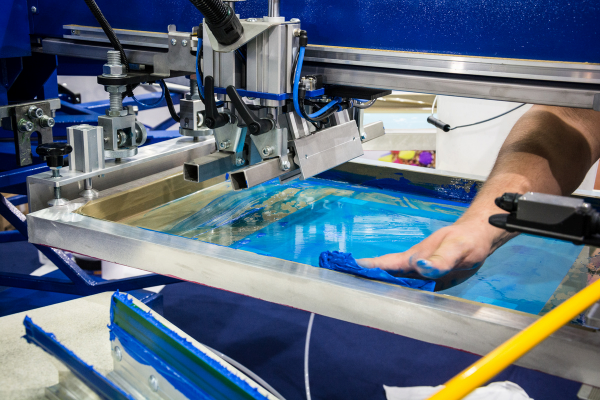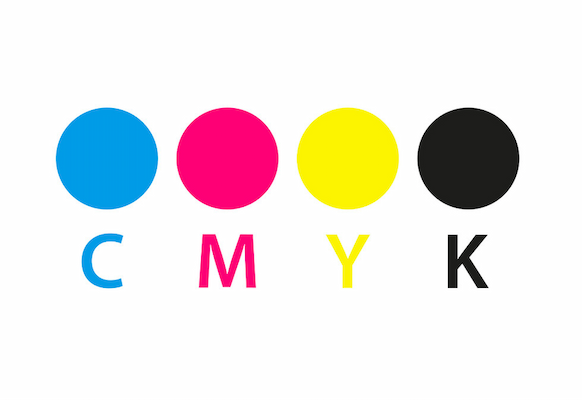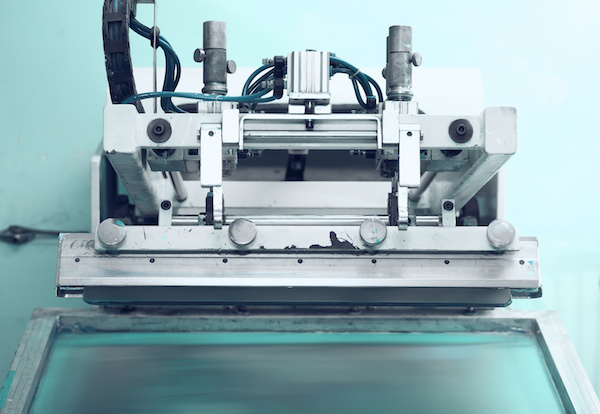Our facility, as well as our expertise, allow us to offer screen printing on many materials for nameplates. But what does this process entail? We are here to fill you in on this process, to help you understand why it just might be the best screen printing process for you.
What is Screen Printing?
Screen printing employs the use of a screen (thus the name) upon which a stencil is applied, using that screen to deliver ink to the surface that is to be printed on.
It is used to create graphics and colored logos, with a wide range of color possibilities. Polyester or enamel inks are printed on metal, followed by baked varnishes for added durability.
Screen printing can be used on stainless steel, aluminum, and brass but aluminum is the most common.
Screen-printed nameplates:
- withstand harsh environmental conditions
- stands out with full-color designs
- usually the most cost-effective type of printing
So how does this process work?
What is the Screen Printing Process?
Screen printing is a printing technique whereby a mesh is used to transfer ink onto a substrate, except in areas made impermeable to the ink by a blocking stencil. A blade or squeegee is moved across the screen to fill the open mesh apertures with ink. A reverse stroke then causes the screen to touch the substrate momentarily along a line of contact. This causes the ink to wet the substrate, and be pulled out of the mesh apertures as the screen springs back after the blade has passed.
There are various terms used for what is essentially the same technique. Traditionally, the process was called screen printing, or silkscreen printing, because silk was used in the process prior to the invention of polyester mesh. Currently, synthetic threads are commonly used in the screen printing process.

The most popular mesh in general use, however, is made of polyester. There are also special-use mesh materials, like nylon and stainless steel, available to the screen printer. Additionally, there are also different types of mesh sizes, which will determine the outcome and look of the finished design on the material.
A screen is made of a piece of mesh stretched over a frame. A stencil is formed by blocking off parts of the screen in the negative image of the design to be printed; that is, the open spaces are where the ink will appear on the substrate.
Pre-Press Process
Before printing occurs, the frame and screen must undergo the pre-press process, in which an emulsion is ‘scooped’ across the mesh and the ‘exposure unit’ burns away the unnecessary emulsion leaving behind a clean area in the mesh with the identical shape as the desired image.
The surface to be printed (commonly referred to as a pallet) is coated with a wide ‘pallet tape’. This serves to protect the ‘pallet’ from any unwanted ink leaking through the screen and potentially staining the ‘pallet’ or transferring unwanted ink onto the next substrate.
Next, the screen and frame are lined with tape. The type of tape used in for this purpose often depends upon the ink that is to be printed onto the substrate. These aggressive tapes are generally used for UV and water-based inks due to the inks’ lower viscosities.
The last process in the ‘pre-press’ is blocking out any unwanted ‘pin-holes’ in the emulsion. If these holes are left in the emulsion, the ink will continue through and leave unwanted marks. To block out these holes, materials such as tapes, specialty emulsions, and ‘block-out pens’ may be used effectively.
Precise Ink Application
The screen is placed atop a substrate and ink is placed on top. A floodbar is then used to push the ink through the holes in the mesh.
The operator begins with the fill bar at the rear of the screen and behind a reservoir of ink. They lift the screen to prevent contact with the substrate and then using a slight amount of downward force pull the fill bar to the front of the screen.
This effectively fills the mesh openings with ink and moves the ink reservoir to the front of the screen. The operator then uses a squeegee (rubber blade) to move the mesh down to the substrate and pushes the squeegee to the rear of the screen.
The ink that is in the mesh opening is pumped or squeezed by capillary action to the substrate in a controlled and prescribed amount. That is the wet ink deposit is proportional to the thickness of the mesh and or stencil. As the squeegee moves toward the rear of the screen the tension of the mesh pulls the mesh up away from the substrate (called snap-off) leaving the ink upon the substrate surface.
The Four Color Process
The Four Color Process, or CMYK color printing, is a manufacturing procedure that uses screens and filters to separate a color image into 4 individual color values. This is called color separation. Software is used to control printers that place the four distinct colors into the right areas to produce the correct colors for the design.

These four colors are CMYK :
- Cyan
- Magenta
- Yellow
- Black
This process uses four plates, one for each color, to create the precise designs that are being asked for. Each different-colored plate is applied one at a time. Precision and accuracy are the keys to creating very detailed and correctly crafted images, copies, and designs.
If there is a misalignment to one color application, the result is a blurry or hazy design. Properly aligned plates will result in a sharp and clear image or copy on your labels and plates.
Key features of this process include:
- Four standard colors (CMYK) are used all the time
- Designs are made with the printing of tiny dots at different angles on the surface of the material
- Considered the most cost-effective method for printing colored designs
- Cheaper than toner-based printing methods
Ready to get started?
Get High-Quality Screen Printing with Hallmark Nameplate
At Hallmark Nameplate we offer high-quality, high-value screenprinting with excellent turnaround time. We’ve invested in top-quality equipment. That means efficient, cost-effective screen printing for our clients and the best color-matching in the industry.
Screen printing is just one of the many techniques we at Hallmark Nameplate use to create beautiful, high-quality products efficiently and without error. Contact us today and give us the opportunity to enhance your nameplate with our high-quality screen printing process!




